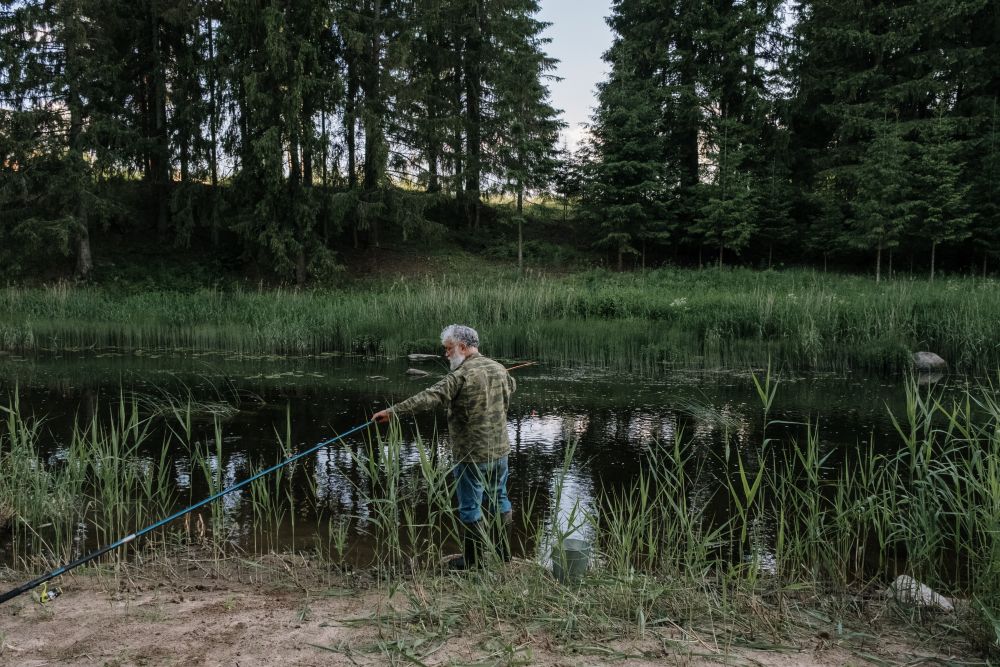Surviving out in the wilderness can be difficult for inexperienced people. You need to find proper shelter, water, and a source of light for the night.
But another crucial point that you always need to think about is a source of food. If you see some water body nearby, you can try to get fish for a food source.
Why Fishing?
While looking out for food, berries and fruits are the most common ones. But there are two downsides to it. One, they are not a good source of protein. They are a terrible choice if you want to recover energy quickly. The second is, some berries could be poisonous. If you eat them without knowing, you could be in more pain than hunger.
Hunting for animals can be tiresome as well. Most animals can outrun an average human, so it is not wise to go hunting.
Thus, the best solution is fishing. It can be done quickly with the help of some tools that almost any adult can make. You can use handmade fishing lures to make the experience more personal.
Fishing Techniques to Aid in Your Survival Situation
1. Gill Nets Are the First Choice
Whether you are fishing in the wilderness for food or in a lake, gill nets should be your first choice. These nets are a little challenging to make, but they provide the best results. Get some thin ropes and tie heavy stones on one end of the rope. Make sure the ropes connect in a crisscross pattern. And now you have a makeshift gill net ready.
Throw the side of the gill net that has the stones. It will fall and trap fishes inside. When you pull it up, you will find yourself with fresh fish to eat.
2. Dip Nets Are an Easy Solution
Fishing with any nets automatically makes matters easy. This is no different with dip nets.
Also known as hand nets, these nets are smaller than gill nets and can be held in one hand because of the handle. But unlike gill nets, they do not work well in deep waters.
You get the most benefit from this net when the water is shallow, and the fishes are small. If you see a swarm of fish, you have to dip the net. Immediately pull the dip net up to catch as many small fish as possible.
3. Fishing with Spears
Spears are also great for fishing. This is the primal fishing method, and our ancestors used wooden spears with a pointy edge to fish.
So, if you are in the wilderness and want to get in touch with your ancestral side, get a hard wooden stick, sharpen the top of the wooden stick to give it a spear-like appearance.
With your spear ready, now move to the nearest water body. This works especially well if the water is clear or shallow, then you will get to see the fish swimming. When you find one, hurl your spear with force, strike the fish, and you get a delicious dinner.
4. Strike the Fish with A Heavy Object
You can use this method if you do not have a sharp object and cannot make pointed edges. To use this technique, you have to get a heavy wooden stick, like a wooden club. It can be any heavy object as long as you can swing it. With the heavy club, go near the water body, and when you spot a fish, swing your club as fast as you can to hit the fish. Although this is a very crude and harsh method but, out in the wild, only the fittest survive.
6. Using Poison to Kill Fish
This is another crude method, but once again, it is the survival of the fittest. But this is much more delicate, and you need to be extra cautious. Since you will be making poison, we suggest that you do not use this method unless you have good knowledge of plants.
If you can spot plants like tephrosia vogelii, adenialobat, mundulea sericea, and neoratanenia, then you are good to go. You mix the plants and spread them across the water body. The poison secreted from the plants will either stun or kill the fish.
However, as you are using poison, the fish itself might be poisonous, so you should only use this method if you are willing to undergo the side effects.
7. Trotlines Can Be A Life Saver
If you do not want the hassle of fishing, use a trotline to do the work for you. This is generally good for still water but can be used in lakes or rivers too. First, you need to find a narrow point in a river or creek that is shallow. Make sure it is close to the riverbank.
Then tie a rope from a tree branch from one bank to the other. Next, hang some fishing line slightly under the water’s surface with the bait attached. Now, wait, and when you pull the fishing lines up, you will find fish caught in the bait.
8. Use Your Bare Hands to Catch
If you do not have any gear available that can be used for fishing, we suggest you use bare hands. This is extremely difficult to pull off, and by now, you will be better off looking for a different food source.
However, if you absolutely must eat fish, then get near a water body, search for fish and if you find any, dip your hand in the water, grab the fish and pull it up as fast as possible.
Things to Avoid While Fishing
Now that you know what you need to do while fishing, you should also look at matters that should be avoided. Bypassing these activities will make your fishing experience much easier and save time in a survival situation.
- No Prior Planning – You need to have a proper plan before you fish. And this includes the method you will be using, when and for how long you will fish. Without these plans, you will waste time. So before you go fishing, make a plan.
- Sudden Movements Can Scare Fish – While you are out fishing, you need to be calm and patient. Any sudden movement will make the fish alert, and they will escape. As they rush away, you will not be catching any fish. Water is the natural habitat of fish, and if you think you can outrun a fish, you are dead wrong. Be as stealthy as possible and avoid making any noise.
- Avoid Making Sounds Too – Not only sudden movements but loud noises can scare fish away too. Fish are extremely alert, and if they feel even the least amount of threat, they will escape away as fast as possible. Any sounds appear threatening to the fish, so when they hear noises, they run away. So apart from being stealthy, you need to be silent too.
- Getting Too Deep in The Water – One thing you should understand, that while you are out in the wild, just as you will face wild animals, you will meet wild fish too. Many predatory fishes are carnivorous. So, if you are not careful, you will be the one who is hunted. Most of the time, these predator fishes remain at the deeper parts of the water. So, while you are on the water fishing, be sure that you do not go deep. There are also poisonous fishes that can sting and paralyze your limbs.
Cooking Fish in The Wild
You got yourself some fish. Congratulations. Let us now look at some methods by which you can cook these fish in the wild.
- Gut the Fish – If you have a sharp object with you, then insert the sharp object into the fish’s belly and cut it toward the head. Be sure not to insert the sharp object too deep as that will gut the intestines.
- Prepare the Fish – Now, scrape out all the fish’s inner parts from the cut: the kidneys, the intestines, and the liver. After taking out the internal organs, cut and remove all the fins and scale the fish with a sharp object. Once these inner organs are out and the fish is cleaned, you can cook the fish.
- Cook the Fish – Your fish is ready and now can be cooked. Prepare a fire, put your fish on a wooden stick and place it on top of the fire. Let the fire grill the fish, and when the entire fish becomes brown, it is ready to eat.
Final Thoughts
Surviving out in the wild without food can be exhausting. But with the help of this article, now you know how to fish and have yourself a secure food source.








































































Pantyhose are great for catching fish. even bunches of minnows in small streams & brooks. Hint (If you’re a girl, take them off first). Also good for other traps. I teach it in my survival classes.
I don’t know if you have ever actually caught a fish with your hands, but I have and so have several of my children ranging from teenagers to 7year olds It is probably near impossible to just grab them quickly and throw them up out of the water. We found it works best in shallow creeks with rocks fish can hide under but not be unable to reach under. Work your hands gently and slowly up under the fish. A gentle touch should not spook them and gives you the best chance to work your hands next to the head and tail at the same time. When you get lined up close hands quickly and trap the fish against the rock. When you are sure you have it firmly in hand, then you can pull it out. Like regular fishing it’s a great exercise in patience.
Gutted fish (but not descaled) can be coated in mud and baked in the coals. Unless the fish is VERY thick, it will cook quickly. When the hard baked mud is broken off, the scales go with it. The inside of the fish could be stuffed with greens, vegetables, and/or herbs, as available.
Disgusting!